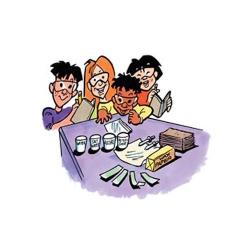Source Institutions
Source Institutions
Add to list Go to activity

Learners identify an unknown liquid by comparing its behavior to known liquids. Learners drop liquids onto different surfaces and see how the liquids behave. Learners realize that using a combination of results from two or more tests will allow them to successfully identify the unknown. Use the related activity "Look-alike Liquids" from the same resource (see related resources) to introduce the behavior of the liquids on different surfaces. [Activity is publicly available through a web crawler capture on Archive.org. Activity write-up only, images are unavailable.]
- 5 to 10 minutes
- 30 to 45 minutes
- 1 cent - $1 per group of students
- Ages 8 - 14
- Activity, Experiment/Lab Activity
- English
Quick Guide
Materials List (per group of students)
- Tap water in cup
- Isopropyl rubbing alcohol (70%) in cup
- Detergent solution in cup
- Salt water in cup
- 1 Additional small cup
- 5 Droppers
- Construction paper
- Notebook paper, copy paper, or newspaper
- Brown paper towel
- Wax paper
- Pencil
- Student Activity Sheet
Subjects
-
Mathematics
-
Data Analysis and Probability
- Data Analysis
- Data Collection
-
Measurement
- Units of Measurement
-
Data Analysis and Probability
-
Physical Sciences
-
Chemistry
- Solutions
-
States of Matter
- Liquids
-
Chemistry
-
The Nature of Science
-
The Scientific Process
- About Inquiry
- Asking Questions
- Conducting Investigations
- Gathering Data
-
The Scientific Process
Audience
To use this activity, learners need to:
- see
- touch
Learning styles supported:
- Involves hands-on or lab activities
Other
Components that are part of this resource:
This resource is part of:
Access Rights:
- Free access
By:
- Kessler, James H. ; Galvan, Patricia M.
Rights:
- All rights reserved, American Chemical Society, 2007
